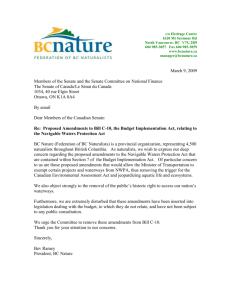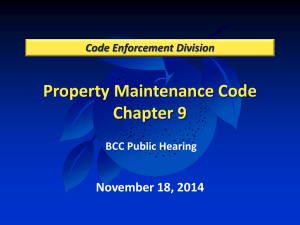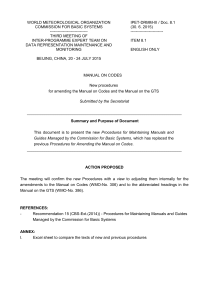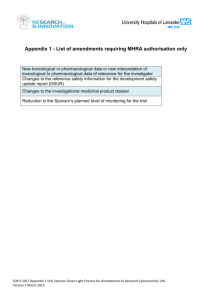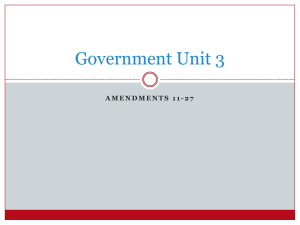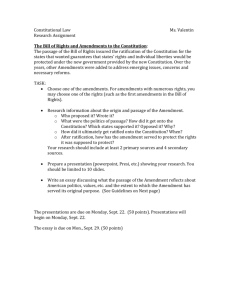Final SEIAS NEMLA 4 BILL
advertisement
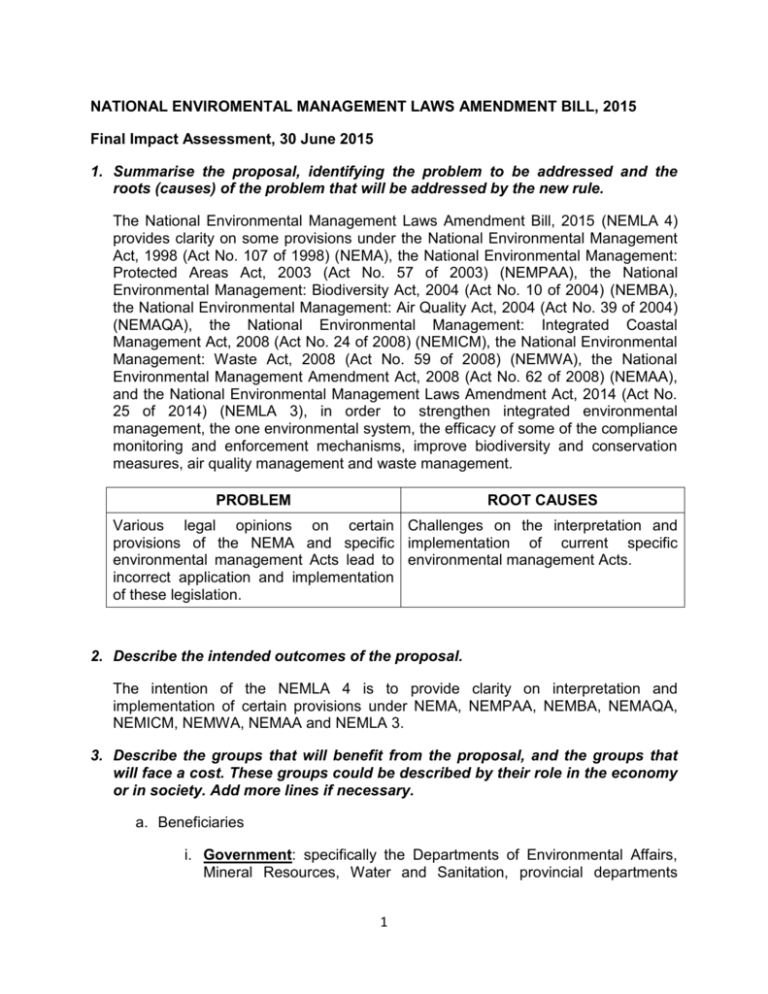
NATIONAL ENVIROMENTAL MANAGEMENT LAWS AMENDMENT BILL, 2015 Final Impact Assessment, 30 June 2015 1. Summarise the proposal, identifying the problem to be addressed and the roots (causes) of the problem that will be addressed by the new rule. The National Environmental Management Laws Amendment Bill, 2015 (NEMLA 4) provides clarity on some provisions under the National Environmental Management Act, 1998 (Act No. 107 of 1998) (NEMA), the National Environmental Management: Protected Areas Act, 2003 (Act No. 57 of 2003) (NEMPAA), the National Environmental Management: Biodiversity Act, 2004 (Act No. 10 of 2004) (NEMBA), the National Environmental Management: Air Quality Act, 2004 (Act No. 39 of 2004) (NEMAQA), the National Environmental Management: Integrated Coastal Management Act, 2008 (Act No. 24 of 2008) (NEMICM), the National Environmental Management: Waste Act, 2008 (Act No. 59 of 2008) (NEMWA), the National Environmental Management Amendment Act, 2008 (Act No. 62 of 2008) (NEMAA), and the National Environmental Management Laws Amendment Act, 2014 (Act No. 25 of 2014) (NEMLA 3), in order to strengthen integrated environmental management, the one environmental system, the efficacy of some of the compliance monitoring and enforcement mechanisms, improve biodiversity and conservation measures, air quality management and waste management. PROBLEM ROOT CAUSES Various legal opinions on certain Challenges on the interpretation and provisions of the NEMA and specific implementation of current specific environmental management Acts lead to environmental management Acts. incorrect application and implementation of these legislation. 2. Describe the intended outcomes of the proposal. The intention of the NEMLA 4 is to provide clarity on interpretation and implementation of certain provisions under NEMA, NEMPAA, NEMBA, NEMAQA, NEMICM, NEMWA, NEMAA and NEMLA 3. 3. Describe the groups that will benefit from the proposal, and the groups that will face a cost. These groups could be described by their role in the economy or in society. Add more lines if necessary. a. Beneficiaries i. Government: specifically the Departments of Environmental Affairs, Mineral Resources, Water and Sanitation, provincial departments 1 responsible for environmental affairs will ensure that the environment is protected in a sustainable manner. ii. Citizen of the country: specifically vulnerable and old persons will enjoy an environment that is not harmful to their health or wellbeing. b. Cost bearers i. Juristic persons: manufacturing industries, mining companies and developers will be required to ensure that their environmental management measures mitigates impact to the environment. In addition to ensure that their activities are undertaken in a sustainable manner. 4. Describe possible disputes arising out of the proposal, and the system for settling and appealing them. How onerous will it likely be for members of the public to lodge a complaint and how burdensome and expeditious is the proposed dispute-settlement procedure? A dispute that may arise relate to compliance with environmental management measure intended to deal with mitigation of impacts to the environment. Section 43 of the National Environmental Management Act, 1998 provides for any person to appeal to the Minister of Environmental Affairs against any decision taken by any person acting under a power delegated by the Minister under this Act or a specific environmental management Act. The appeal process allows any person, without relying on the services of a lawyer, to submit his or her appeal to the Minister. The process has specific timeframes applicable both to the appellant and the Minister. 5. Describe the behaviour that must be changed, and the main mechanisms to achieve the necessary changes. These mechanisms may include modifications in decision making systems; changes in procedures; educational work; sanctions; and/or incentives. The interpretation and implementation challenges may lead to non-compliance with the current environmental legislation. These challenges may economically benefit those juristic persons required to comply with the law, and at the same time may cause harm or degradation to the environment which may be harmful to the health and wellbeing of the citizens of the country. The amendments strengthen the Department of Mineral Resources as a competent authority to streamline processes. The amendments to allow the Chief Financial Officers of the South African National Parks and South African National Biodiversity Institute will ensure that the Board is always abreast with the financial situation of these organisations. 6. Identify the groups inside and outside of government whose behaviour will have to change to implement the proposal (add more lines if required). a. National Department of Environmental Affairs; 2 b. National Department of Mineral Resources; c. Provincial Departments responsible for environmental affairs; d. Metropolitan and District Municipalities; e. Mining companies; f. Manufacturing companies; g. Developers; h. Non-government organisations. 7. Report on consultations on the proposal with the affected government agencies, business and other groupings noted in the previous point. What do they see as the main benefits, costs and risks? Do they support or oppose the proposal? What amendments do they want, and have these amendments been incorporated in your proposal? 3 The provincial departments responsible for environmental affairs and municipalities were consulted through our MinMec processes and most of their inputs were incorporated in the final draft NEMLA 4 Bill. The draft Bill will be published for public comment after approval by Cabinet in order to allow members of the public to submit inputs and comments. Affected stakeholders What do they see as main benefits, costs and risks Do they support or oppose the proposal What amendments do they propose Have these amendments been incorporated in your proposal Departments of environmental affairs, mineral resources and provincial departments of environmental affairs. Alignment of processes and compliance and enforcement provisions. Yes. Alignment of licensing provisions and compliance and enforcement provisions. Yes. Mining, manufacturing and developers Streamlining of processes and timeframes for issuing licences. Yes. Streamlining of licensing provisions and set timeframes for issuing of licences. Yes. Nongovernmental organisations Improved Yes. environmental management measures and compliance and enforcement measures. Improved compliance and enforcement measures. Yes. 8. Estimate the costs and benefits of implementing the proposal to the groups identified in point 6 above, using the following chart. Add more lines if required. Group Implementation Cost of costs changing behaviour 4 Costs/benefits Comments from achieving desired outcome Group Implementation Cost of costs changing behaviour Costs/benefits Comments from achieving desired outcome a. National Department of Environmental Affairs Utilise existing human capital and financial resources to implement existing environmental legislation in consideration of the proposed amendments. Existing resources to be utilised to implement proposed amendments. Sustainable development. None. b. Provincial Departments responsible for environmental affairs Utilise existing human capital and financial resources to implement existing environmental legislation in consideration of the proposed amendments. Existing resources to be utilised to implement proposed amendments. Sustainable development. None. c. Metropolitan and District Municipalities Utilise existing human capital and financial resources to implement existing environmental legislation in consideration of the proposed amendments. Existing resources to be utilised to implement proposed amendments. Sustainable development. None. d. Citizens of the country None None None None 9. Describe the changes required in budgets and staffing in government in order to implement the proposal. Identify where additional resources would be required for implementation. It is assumed that existing staff are fully 5 employed and cannot simply absorb extra work without relinquishing other tasks. National department, provinces and metropolitan and district municipalities are to utilise existing human capital and financial resources to implement the proposed amendments. 10. Describe how the proposal minimises implementation and compliance costs. The proposed amendments, where possible, requires the streamlining of legal processes or requirements, for purposes of smooth implementation and to avoid duplication of legal requirements. 11. Describe the main risks that could arise from adoption of the proposal. Add more lines if required. a. Non-compliance with proposed amendments. 12. Describe the measures taken to manage the identified risks. Add more rows if necessary. Identified risk Mitigation measures a. Non-compliance with The spheres of government must monitor compliance and proposed amendments. pursue enforcement measures where non-compliance is uncovered. In addition, through the MinMec structures spheres of government meets quarterly to discuss implementation of legislation, share challenges and propose solutions. 13. Describe the mechanisms included in the proposal for monitoring implementation, evaluating the outcomes, and modifying the implementation process if required. Estimate the minimum amount of time it would take from the start of the implementation process to identify a major problem and remedy it. Chapter 7 of the National Environmental Management Act, 1998, as a framework environmental legislation, provides for compliance and enforcement measures where non-compliance with any of the environmental legislation is detected. This Chapter provides for various administrative and enforcement tools. 14. Summarise the impact of the proposal on the main national priorities. 6 Priority Impact Social cohesion None. Security None. Economic growth and investment The proposed amendments may progressively lead to transition to a green economy which is competitive and sustainable. Economic inclusion (employment creation and equity) The proposed amendments may progressively lead to transition to a society and green economy which is competitive, sustainable and equitable. Environmental sustainability The proposed amendments may progressively lead to a progressively prosperous and equitable society living in harmony with our natural resources. 15. Identify the social and economic groups that would benefit most and that would bear the most cost. Add more rows if required. Main beneficiaries Main cost bearers 1. Government 1. Juristic person 2. Citizen of the country 3. Non-governmental organisation in the environment sector 7 16. In conclusion, summarise what should be done to reduce the costs, maximise the benefits, and mitigate the risks associated with the legislation. Note supplementary measures as well as amendments, if appropriate. Add more lines if required. The streamlining of legal requirements or processes and simplified environmental management tools (which are currently provided for in the existing environmental legislation) across the environmental legislation may maximize the benefits not only for government but for juristic persons. Existing environmental legislation must be implemented properly. 17. Please identify areas where additional research would improve understanding of the costs, benefits and/or risks of the legislation. None. 8
